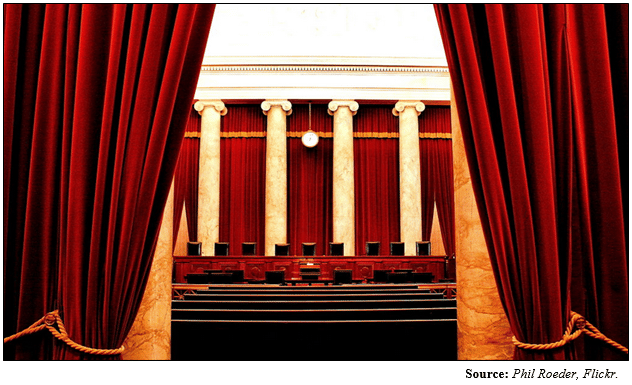
The Supreme Court granted a petition for a writ of certiorari to former President Donald Trump on Jan. 5 for an appeal to Maine and Colorado’s decisions removing him from the presidential primary and general election ballots in those states when the states alleged Trump had engaged in insurrection against the United States by giving a speech on Jan. 6, 2021 at the National Mall where he urged supporters to “peacefully and patriotically make your voices heard” prior to the riot at the U.S. Capitol that day as Congress considered challenges to the 2020 presidential election.
According to the Court, oral arguments will be immediately heard on Feb. 8: “The petition for a writ of certiorari is granted. The case is set for oral argument on Thursday, February 8, 2024.”
And the parties have just a few weeks to prepare for the hearing: “Petitioner’s brief on the merits, and any amicus curiae briefs in support or in support of neither party, are to be filed on or before Thursday, January 18, 2024. Respondents’ briefs on the merits, and any amicus curiae briefs in support, are to be filed on or before Wednesday, January 31, 2024. The reply brief, if any, is to be filed on or before 5 p.m., Monday, February 5, 2024.”
The fact that the Supreme Court is hearing the case could be a very good sign for former President Trump that the Court is strongly considering overturning the decisions by Maine and Colorado, since particularly the Colorado Supreme Court’s ruling has been stayed pending an appeal from federal courts including the Supreme Court.
That is, if the Supreme Court had rejected Trump’s petition for a writ of certiorari, denying the capacity for an appeal, the Colorado ruling could have immediately gone into effect, allowing Trump’s removal from the ballot to occur.
Instead, the case will be heard, and so the Colorado Supreme Court’s decision will remain stayed, pending the outcome of the case at the U.S. Supreme Court.
On its merits, it’s hard to imagine the Supreme Court upholding the Colorado and Maine decisions, particularly since Trump has neither been tried nor convicted in criminal court for the charge of insurrection.
The House of Representatives impeached Trump for insurrection in 2021, and the Senate acquitted him. That is, Trump was found not guilty of insurrection already, as Senators voting in the negative found he had a First Amendment right to give the speech at the National Mall on Jan. 6, 2021.
Under the Fourteenth Amendment’s Section 3, it states “No person shall … hold any office, civil or military, under the United States … who, having previously taken an oath … as an officer of the United States … to support the Constitution of the United States, shall have engaged in insurrection or rebellion against the same, or given aid and comfort to the enemies thereof.”
The Colorado ruling states, “A majority of the court holds that President Trump is disqualified from holding the office of President under Section Three of the Fourteenth Amendment to the United States Constitution. Because he is disqualified, it would be a wrongful act under the Election Code for the Colorado Secretary of State to list him as a candidate on the presidential primary ballot.”
It even claimed Congress did not have to set the contours of insurrection via legislation, stating, “Congress does not need to pass implementing legislation for Section Three’s disqualification provision to attach, and Section Three is, in that sense, self-executing…” even though Section 5 of the Fourteenth Amendment explicitly states, “The Congress shall have power to enforce, by appropriate legislation, the provisions of this article.”
Before the Fourteenth Amendment was ratified in 1868, Congress had already supplied a procedure for disqualifying former Confederate officers and soldiers from running for public office in the First Military Reconstruction Act of 1867. The disqualification required military tribunals, speedy trials and convictions, also ratification of the Fourteenth Amendment in order for states to be readmitted to the Union.
This was enforced in part by the Enforcement Act of 1870, which provided in Sections 14 and 15 for federal prosecutors to bring cases that would remove individuals from holding public office if they had participated in the Confederacy. It was not self-executing, it required convictions.
Section 14 stated, “That whenever any person shall persons hold office, except as a member of Congress or of some State legislature, contrary to the provisions of the third section of the fourteenth article of amendment of the Constitution of the United States, it shall be the duty of the of the district attorney of the United States for the district in which such person shall hold office, as foresaid, to proceed against such person… [in] the circuit or district court of the against by United States in such district, and to prosecute the same to the removal of such person from office.” Here, Congress was explicitly holding onto its own power to disqualify its own members, and of states to do the same. Under no reading, however, would this provision have applied to the President, to be removed, since that is covered under impeachment, removal and disqualification as under the Constitution. In this case, officers of the United States, that is, federal employees, could be removed from office if they were later tried and convicted of participating in the Confederacy.
Section 15 provided that upon conviction, a person who had participated in the Confederacy and held public office and was removed, would be guilty of a misdemeanor, imprisoned for no more than a year and fined no more than $1,000.
When it came to removing the former Confederates’ disability of running for public office, that was once again Congress. Congress had already removed political disabilities for 4,616 former Confederates by March 1871. And then, with the Amnesty Act of 1872 to remove all political disabilities “except Senators and Representatives of the Thirty-sixth and Thirty-seventh Congresses and officers in the judicial, military, and naval service of the United States, heads of Departments, and foreign ministers of the United States.”
And again, in 1896, it was Congress who voted to allow former Confederate officers to rejoin the U.S. armed forces. And in 1898, the Section 3 bar was removed completely by Congress. Every time, this was done by two-thirds votes required of Congress to remove the political disabilities under Section 3.
So, during Reconstruction, it was the military districts who would try rebels that were in military captivity. And afterward, if a member of the Confederacy were in the federal civil or armed services, it would be federal prosecutors who would bring a charge and seek conviction and removal of said officers, all under processes Congress established.
The alternative argument, that any state can arbitrarily remove any candidate from the ballot for being an insurrectionist without any process supplied by Congress and conviction by a court or tribunal, seems to lack any merit, and has created a very potent constitutional crisis.
But we will soon see what the Court does. It seems doubtful the Supreme Court would hear this case if it was not already leaning to overturning the removals from the ballot, or else it might have punted and just let the removals stand. No less than the fate of the Constitution and the civil society hang in the balance.
Robert Romano is the Vice President of Public Policy of Americans for Limited Government Foundation.






